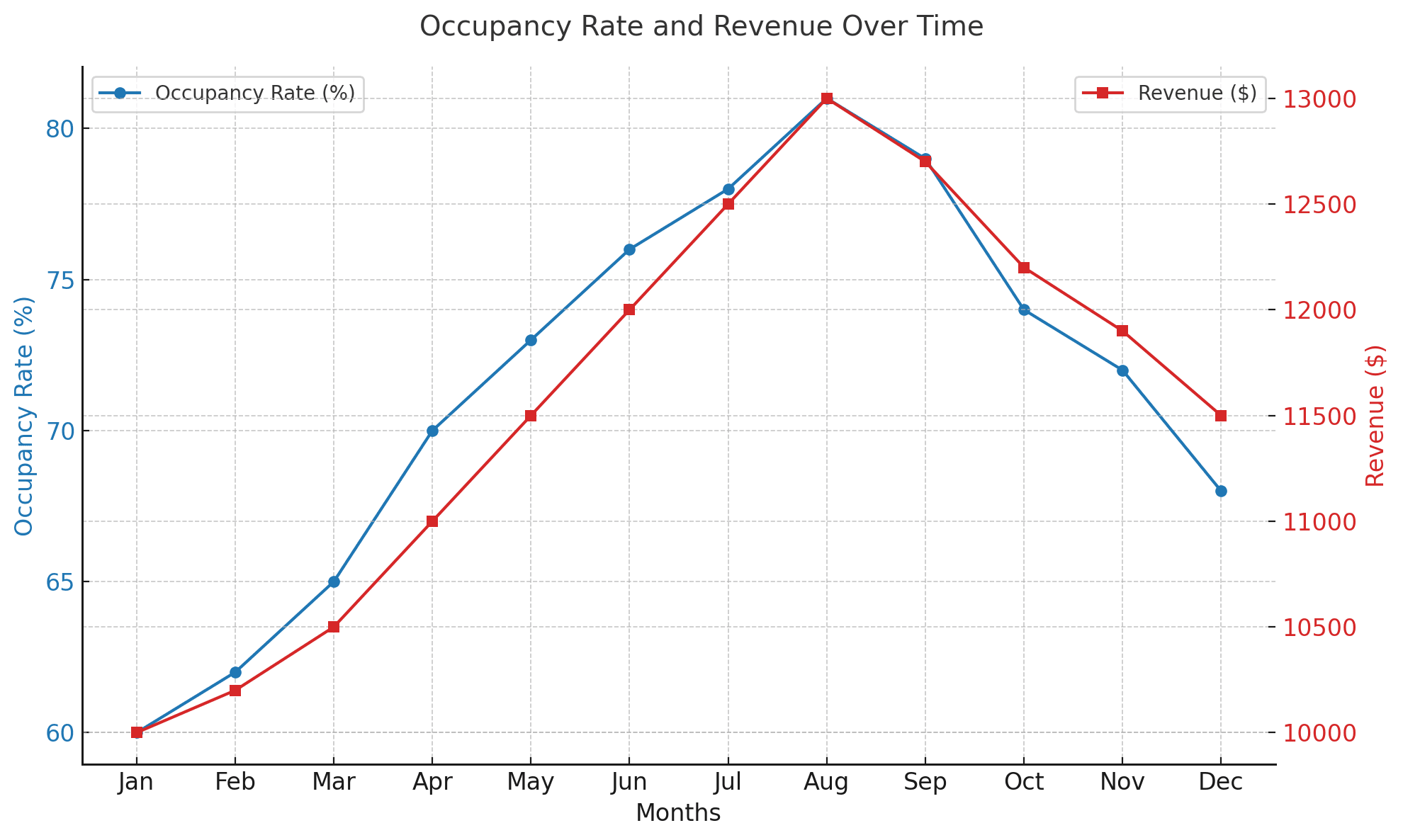Missed the live session? No worries! Watch the full recording of our recent webinar to learn how yield management tools can revolutionize your budgeting process.
Enhancing Budgeting with Yield Management Tools
When it comes to budgeting, many organizations focus on numbers alone, missing out on the powerful impact of strategic yield management. Recently, we hosted a webinar titled “Elevate Your Budgeting Process with Strategic Yield Management” to address just this topic. Led by Nick Stevens and Kurt Tingey, this session offered a comprehensive look at using yield management as a foundational tool to drive smarter, more flexible budgeting practices.
During the session, Nick and Kurt unpacked key strategies like the use of occupancy data, scenario-based planning, and tailored incentive structures to help you get more from your budgets. By aligning budgeting processes with strategic goals, yield management turns a static budget into a responsive, growth-oriented plan.
Below, we’ll walk through the core insights and actionable tips shared in the webinar to help you elevate your own budgeting process. For those who want to dive even deeper, we invite you to watch the full webinar for a firsthand look at these strategies in action.
1. Understanding Yield Management in Budgeting
Yield management isn’t just about setting prices or forecasting revenue; it’s a strategic approach to make every part of the budgeting process work toward your growth goals. As Kurt explained during the webinar, budgeting should be more than a routine exercise of adding up numbers from last year—it’s an opportunity to shape your organization’s priorities and fine-tune your financial strategy.
In practice, this means starting each budget cycle by identifying where you want your organization to grow and improve. Yield management tools allow you to turn these goals into concrete actions, like adjusting prices to reflect occupancy rates or setting incentive structures to motivate your team.
By applying yield management techniques, budgeting becomes a dynamic process where strategy leads, and numbers follow.
Actionable Tip: Start each budgeting cycle by setting specific, strategic goals that go beyond basic revenue increases. Consider where you want to improve, grow, or adjust—whether it’s by refining your pricing approach, increasing your occupancy, or entering new markets. This creates a clear purpose for your budgeting efforts and gives your team a focus that will drive measurable results.

2. Using Occupancy Data to Drive Budget Decisions
Occupancy rates are one of the most valuable metrics in yield management, providing a data-backed foundation for setting realistic revenue goals and identifying growth opportunities. During the webinar, Nick and Kurt demonstrated how occupancy data, segmented by factors like market, region, and product type, can highlight both high-demand areas for potential price increases and low-demand zones that could benefit from targeted sales efforts.
For instance, analyzing your occupancy rates to identify a target threshold—like a 75-80% occupancy rate—allows you to prioritize resources effectively. Higher occupancy markets might call for pricing adjustments, while markets with lower rates present an opportunity to drive sales through incentives or other promotional efforts.
Actionable Tip: Regularly analyze your occupancy data across key segments (such as region, product type, or market) to align your revenue targets with your market’s unique demands. Use this data to make yield rules that automate precise adjustments to pricing and sales strategies, creating a more responsive and informed budgeting process.

3. Designing Effective Incentives for Sales Teams
In any market, motivating your sales team can be key to driving results, especially in areas where demand may be lower or where occupancy needs a boost. During the webinar, Nick illustrated how adjusting commission structures in specific markets can encourage sales teams to prioritize certain areas, helping improve occupancy rates and overall revenue. For example, by offering an additional 2% commission in regions with lower occupancy, you can direct sales efforts where they’re needed most.
Customizing incentives in this way not only helps you achieve revenue goals but also allows you to address gaps in your budget in a targeted, strategic manner. This flexibility is a core strength of yield management, turning traditional commission models into dynamic tools for both performance and revenue growth.
Actionable Tip: Evaluate your market data to identify regions or product types where sales could be boosted by a tailored commission structure. Consider offering additional incentives for sales in low-occupancy areas or for certain types of inventory, and then building those incentives into your business using the yield management tools in the system. This approach makes your sales team a partner in hitting your occupancy and revenue targets, turning incentives into a proactive budgeting tool.

4. Building Flexible Budgets through Scenario-Based Planning
One of the standout advantages of yield management is the ability to build flexibility into your budgeting process. During the webinar, Nick and Kurt emphasized how scenario planning can prepare your budget for fluctuating occupancy levels, seasonal demand, and market-specific trends. By creating different budget scenarios, such as a high-demand or low-occupancy outlook, you can set realistic targets and pre-plan actions to optimize results.
For example, in a high-occupancy market, you might plan to raise rates and reduce discounts, while in a low-occupancy scenario, you could introduce incentives to attract more business. This kind of proactive planning keeps your budget responsive and allows you to adapt to real-time data, helping you achieve your financial goals despite market variability.
Actionable Tip: Regularly assess a few key scenarios (e.g., high occupancy, low demand, peak season) and pre-plan your budget strategy for each. Then build yield rules to dynamically adjust rates, incentives and more based on your custom criteria. This way, you’re prepared to implement rate changes, incentives, or targeted promotions on the fly as soon as shifts in occupancy or demand occur, keeping your budget aligned with actual market conditions.

5. Monitoring, Testing, and Adjusting Your Yield Management Rules
Yield management is not a one-and-done process—it requires ongoing monitoring and adjustments to stay aligned with your revenue and occupancy goals. During the webinar, Nick and Kurt shared insights on the importance of testing yield management rules before implementing them, as well as the need to continuously review their impact on revenue and occupancy.
With yield management tools, you can regularly test how changes to incentives, discounts, or pricing affect your targets. If you notice that a rule isn’t driving the expected results, you can deactivate or adjust it to better suit current conditions. This kind of responsive budgeting keeps your strategies optimized and ensures that you’re consistently working toward your financial objectives.
Actionable Tip: Schedule quarterly reviews of your yield management rules to assess their effectiveness. Use your analytics to pinpoint areas where rules may need refining or where new rules could help. This proactive approach allows you to fine-tune your budget based on real performance data, keeping your budgeting process agile and effective.
Conclusion
Strategic yield management has the power to transform budgeting from a static process into a dynamic, growth-oriented strategy. By leveraging data-driven insights, designing tailored incentives, planning for various scenarios, and continuously monitoring your approach, you can unlock greater flexibility and efficiency in your budgeting process.
As discussed in our recent webinar, yield management is not just about adjusting prices; it’s about aligning your financial goals with actionable strategies to maximize occupancy and revenue. We hope these insights provide a solid foundation for you to apply yield management principles in your own budgeting, whether you’re refining existing processes or building a new strategy from scratch.
For a deeper dive into these techniques and more real-world examples, we invite you to watch the full webinar. Let us know if you’d like guidance in implementing these methods, and take the next step toward elevating your budgeting strategy.
Enhance your budgeting with yield management
Catch up on other yield management training
Say Hello to Smarter Pricing
Setting the right rates is a wildly complex puzzle.
You have to balance optimal occupancy, rate, costs, and commissions all on a nearly daily basis in a complex business environment.
But what if it no longer has to be?
What if those pieces of data were at your fingertips, and you could strategically and instantly make updates to how you sell to meet the changing markets you work in on a daily basis?
Your Questions Answered
How do yield management tools improve budgeting?
Yield management tools help optimize pricing and inventory, leading to more accurate budgeting and financial forecasting.
Can these tools integrate with existing systems?
Yes, our yield management tools are seamlessly built into the Apparatix system, enhancing overall efficiency.
Are there any prerequisites for using these tools?
Nope! All Apparatix users have access to the yield management software module within the Apparatix system.
How quickly can we see results after implementation?
Many users report noticeable improvements in budgeting accuracy and efficiency within the first few months of use.
Apparatix Has The Yield Management Tools You Need
Dynamic Pricing Rules
Implement flexible pricing strategies to maximize revenue and adapt to market changes automatically and effectively.
Automated Incentives
Motivate your team with incentive structures that seamlessly adapt based on your strategic goals.
Empowering Reports & Analytics
Utilize data-driven insights to forecast financial trends and make informed budgeting decisions.
Request a Demo
Don’t miss out on the opportunity to transform your budgeting strategy with powerful yield management tools. Request a demo today to stay ahead in the industry and explore how Apparatix’s innovative software solutions can streamline your operations and maximize efficiency.




